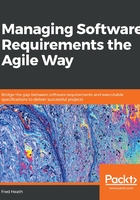
Chapter 1: The Requirements Domain
Now that we know what this book is about, we can begin our exploration of the requirements domain. A domain is an area of knowledge within which we can operate. As software professionals, we move between different domains daily: the coding domain, the testing domain, as well as client-specific domains such as banking, engineering, education, and so on. In every domain, we deal with specific domain entities that represent items of knowledge or interactions within the domain. In the coding domain, for instance, we deal with entities such as data structures, algorithms, functions, and so on. These entities reflect how we capture and utilize domain knowledge. The aim of this chapter is to introduce you to the requirements domain and its entities.
We will start by explaining the meaning of requirements and specifications, and discussing the requirement life cycle. We will then define the role of stakeholders and actors and talk about the goals they have in relation to our system. Lastly, we will consider the importance of bridging the gap between requirements and specifications and how this book will be approaching this problem. The main sections herein are as follows:
The requirements domain
Identifying stakeholders
Identifying goals
Goals, requirements, and specifications: a traveling analogy
Crossing from requirements to specifications
By the end of the chapter, you will know the difference between and the importance of requirements and specifications, as well as the stages requirements move through during a project's life cycle. You will also be able to create and validate stakeholder goals, understanding the importance of writing specifications, the pitfalls with current approaches, and how this book will be tackling this subject.